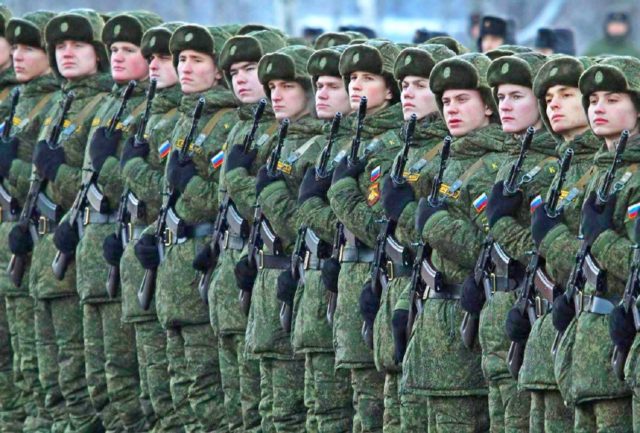
2018 Spring Draft Highlights Russia’s Demographic Decline
Publication: Eurasia Daily Monitor Volume: 15 Issue: 54
By:

When a country is faced with demographic decline—an excess of deaths over births and a reduction in the number of individuals annually entering adulthood—one of the first areas its government must undertake hard choices is military conscription policy. That is exactly what the Russia government now confronts. Like its Soviet predecessor, the Russian Federation calls up draftees twice a year. And its response to the spring 2018 draft shows that that the country’s continuing demographic decline—all of President Vladimir Putin’s upbeat talk notwithstanding—is not only steep and accelerating but affecting this most important sector of the Russian state.
The first thing a government can do to address ever smaller numbers of men in the prime draft-age groups is to simply cut the size of the draft. Russia has, in fact, done this, despite its increasing militarism. This spring’s draft of 128,000 men is the smallest since 2006 (Meduza, March 30). Officially, Moscow has justified this reduction by pointing to its shift toward a professional army. But such a strategy only works if the military is able to attract and afford for more people to voluntarily serve in a professional capacity. In Russia, this is limited both by economics—it costs far more to have a professional military than a draft-based one—and by the shrinking number of new entrants into the prime recruiting age cohort, which is the same as that for draftees. Polls showing rising support for the Russian military and a declining economy could be expected to make military service more attractive. But in actuality, the Russian Armed Services are not achieving sufficient success in attracting enough volunteers to completely fill the ranks (Vedomosti, February 22, 2018; Gazeta.ru, February 22, 2016).
The second option for a government is to cut the number of deferments and go after real or potential draft avoidance. The Russian authorities have done both. They are reducing the number of deferments allowed, something that has sparked controversy and led to court cases (Rosbalt, March 29; Ura.news, April 4). Moreover, the authorities have imposed new rules requiring potential draftees to show up at military commissariats even if they have not received official notifications; and the government promised to go after men who seek to avoid service (Krasnaya Zvezda, Znak.com, March 30; Riafan.ru, March 19). Additionally, Russia has called up reservists. Moscow does this every year to test the system; but this year, it appears that the 5,000 members of the reserves ordered to report may be filling slots left vacant by the latest draft (9111.ru, April 3).
And third, a government can try to create conditions that allow the dwindling numbers of young people to fill both the military ranks and workplaces in the economy at the same time. This week (April 9), President Putin ordered the military to generate a plan for draftees to be sent as laborers to defense factories in the Urals so that Moscow might come closer to meeting its draft goal without further harming the economy by generating labor shortages (Newizv.ru, Vpk-news.ru, April 9). Other governments have also employed this approach in the past, but typically only in wartime. That Putin has chosen to use this option now is, in part, an indication of how difficult Russia’s demographic situation actually. But it addition, the presidential decree also highlights Putin’s possible intentions.
What is most striking in this situation is that the Kremlin itself has adopted a number of policies that have further limited the size of the naturally shrinking draft pool, thus making its manning tasks even more difficult. On the one hand—and this involves a relatively small number of men—Moscow has made clear that it will not conscript transgender individuals, something draft commissariats are likely to extend to the perhaps 10 percent of the cohort who are gay (Ura.news, April 4). And on the other hand—and this is more serious—it is again restricting the draft in Muslim regions in the North Caucasus, places where there are relatively larger cohorts of draft-age men and where many young men want to serve precisely because this a prerequisite for work in the local police or other force structures.
Numerous reports have been published about this restriction in Dagestan, first imposed at the time of the first Chechen war in the mid-1990s but lifted three or four years ago (see EDM, April 23, 2014). Yet, the ban on Dagestani Muslim conscripts appears to persist unofficially and almost certainly continues to be enforced elsewhere in the North Caucasus—and perhaps even more widely (Kavkazr.com, April 3, 2018). Many officers and Russian government officials do not want to have the number of Muslims in the ranks reflect their true percentage in the draft-age cohort. That figure is significantly higher than Muslims’ overall share of the Russian population (15–18 percent) because the Muslim nationalities are still growing more rapidly than the non-Muslim and especially Slavic ones. The authorities fear ethnic conflicts in the ranks and a deterioration of unit cohesion and readiness (Idelreal.org, March 20).
Obviously, the Kremlin could avoid the impact of all these demographic problems by cutting the size of the military; but Putin’s foreign policy hardly allows for that. Moreover, his announced shift in spending from personnel to new and high-cost weaponry almost certainly means that Russia will have to rely on the draft for some time to come. Meanwhile, Russia’s population decline will last at least over the next decade if not longer (Iarex.ru, April 9). Perhaps by the mid-2030s, there will be an uptick in the size of the draft pool because of slightly improved birthrates over the last few years; but that is likely to be after Putin leaves power, and so he will continue to struggle with these demographic constraints throughout his remaining time in office.



